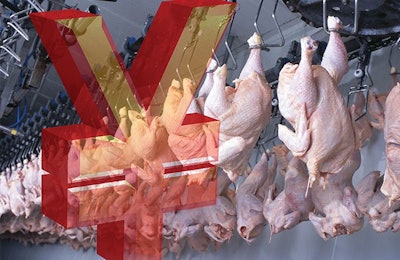
2019 should be a year of gradual improvement for the local poultry industry, according to the latest report from Rabobank, in contrast to the difficulties experienced last year and a weakening overall economic outlook.
Global trade in poultry products is thought to have declined by 2 percent last year, a similar figure to the contraction experienced in 2017. And while the first half of this year is forecast to remain volatile, markets should start to see improvements by the second half.
The issues of 2018, however, will continue into the new year, including tensions in trade between the U.S. and China, changing standards in Saudi Arabia, the exclusion of some Brazilian plants from the European Union (EU) approved list, and, as ever, ongoing disease risks.
Under such challenging market conditions, a balanced supply strategy can help to maintain profitability, Rabobank advises, noting that this strategy has already benefited Brazil -- which cut output by 2 percent last year -- Russia and South Africa. Similar benefits could be accrued by Thailand and the EU, which are both experiencing oversupply.
The first six months of 2019 will see a continuation of volatility and high levels of competition. In some major markets, low prices for competitor proteins will pressure poultry producers, yet in others a lack of supply or consumer fears over food safety are pushing chicken prices ever higher.
Rabobank points to a number of key factors to be aware of as the year progresses.
China
China is expected to see continuing strong demand and ongoing record-breaking prices in 2019.
The country’s poultry meat imports saw double-digit growth over the first 10 months of 2018 and, by year-end, broiler prices had reached record highs.
Supplies of pork in the country this year will continue to be constrained by outbreaks of African swine fever, and demand weakened due to consumers’ food safety concerns. However, local poultry producers will not be able to fully respond to the rising demand for chicken meat due to limited grandparent stock, meaning that China must import more.
This could be particularly positive for Brazil, which already accounts for 80 percent of supplies to China, but could also benefit other suppliers including Russia and Eastern European countries such as Ukraine. However, lack of supply could lead to imports being sourced from the U.S., shut out of the Chinese market since 2015 due to concerns over avian influenza.
Difficulties in the Chinese market are expected to continue as 2019 progresses with supply remaining tight into the second half of the year.
Brazil
Brazil’s industry is recovering from what has been described as the “perfect storm,” and has reduced supply and adopted more focused and diversified export strategies. While the country continues to experience pressure on its exports to the EU and Saudi Arabia, it is likely to make gains in markets such as China, the United Arab Emirates and South Korea.
Twenty Brazilian export plants lost their EU export permits after the Weak Flesh scandal, depressing global breast meat prices, and full access is not expected to be restored for at least another 12 months.
However, as the year progresses, Brazilian producers are expected to benefit from the gradual recovery in exports that started late last year, with the Middle East and Asia being particularly important markets.
On the home market, the modest improvements in animal protein consumption registered over the past couple of years are expected to continue in 2019.
Trade deals
A possible Sino-American trade agreement could have a significant impact on the outlook for global trade. It could result in the U.S. again exporting to the Chinese market, posing a challenge to Brazil. Removal of soybean tariffs would create new volatility in global grain markets.
Disease
Avian influenza is a wild card for the global outlook. The number of outbreaks has, of late, been lower than in recent years, but pressure is usually high during the first quarter and significant outbreaks could quickly change the outlook.
Need for rebalancing
2018 was one of the most turbulent years for the global poultry industry in decades, with volatility in trade, rapidly shifting trade flows and unstable prices. A similar pattern will remain evident into the first half of 2019.
The U.S. and the EU continue to face issues with oversupply. In the former, there is record high broiler and red meat production, low domestic prices, and high cold storage levels. However, the possibility of re-entering lost export markets may help to offset this. Nevertheless, the downward pressure on prices, declining profitability and, in some cases, losses, suggest that production will slow in 2019.

Plentiful supplies across animal proteins in the U.S. is pushing the price of chicken down and impacting margins, suggesting that producers will have to limit supplies to remain profitable. (Jeff Miller)
Supply issues are also expected to continue to affect the EU this year. Production increases last year, particularly in Eastern Europe, together with low pork and beef prices, mean that supply needs to be better matched to demand. While rising pork prices will improve chicken’s position, and imports are expected to be lower, a rebalancing will be needed to reduce pressure on margins.
Poultry Trends 2018

















